Indian history myths, narratives and overcorrections 🏗️
Table of Contents
Most people you see online saying things authoritatively really just got all their information from Wikipedia, so don’t believe them uncritically. Fun study: by making edits to Wikipedia, researchers were able to alter court judgement wordings in Ireland. Wikipedia itself has its own cliquey politics, and even in the idealization is only meant to reflect current academic coverage (plus what some activist projects demand be emphasized, like “Women in Red”, “WikiProject Africa”).
But academic Indology has seen knowledge destruction since the 1970s, due to factors largely exogenous to Indian politics:
- A general decline in competence in the humanities, especially pronounced in marginal topics like Indian history — as a result, the results of detailed topical study fell out of general narrative-setting tertiary sources (which, btw, are the ones that Wikipedia relies on most)
- The rise of “postcolonialists” — the less said about their weird psychological states the better; I will just leave this very on-point take by [cite/t:@IndianBronson] here.
- Seriously studying Indian history is associated with “Hindu nationalists”, who are coded as enemies (and who do not do themselves any favour in acting as inerudite as possible)
Bad ways to respond to this include:
- Inane conspiratorial explanations (no, there are not evil geniuses, they have no complex intentions, everything is just the product of some silly social dynamics)
- Trying to curry the left’s favour by using their lingo like Hinduphobia and decolonialization (no, these are not dumb people, they know you are the enemy, you can’t “fool” them)
You will never be afforded the generosity that Afrocentrists or feminists are — you will never be seen as friend — and you shouldn’t be trying (to sell your intellectual honesty for a position in their ranks), in the first place.
Generally I think when an institution (mainstream Indology) sucks, it is best to mostly ignore them and develop your own parallel, more competent ones. The humanities are just no good, their acceptance mechanism is based on authority, consensus and other social nonsense rather than any truth orientation. You don’t even need to seriously address or debunk their claims, they are obviously false to anyone whose IQ exceeds their age, you just need to incessantly mock them until “Wikipedia University” becomes as low-status as “WhatsApp University”. The problem with this is:
- The only thing that unites contrarians is their disagreement with the status-quo, and there are many more ways to be wrong than to be right, so most “alternative” anything is bunk (this is a general problem for the political right, because the only defining feature of the right is their opposition to the left).
- I have a need — a primal, insatiable need — to write rebuttals to wrong things, people being wrong is just a giant DDOS attack on my senses and on my productive life and there’s nothing I can do about it, I MUST DO IT.
Some of the things I respond to are straight-up falsehoods; some are weird narratives that suggest either bias or insularity; and for some I also respond to “right-wing overcorrections” (quack kanging).
++ weird spin: importers have power, Tamils just saw as gifts, arab and chinese cola, Second Urbanization, Sangam secular or Jain/Buddhist, weird maps
Civilization: Brāhmī, water-wheels, coins, Pythagoras ️ Dating: Kautilya, Gustav Oppert gunpowder, Ayodhya, Ramayana/MBh
https://twitter.com/PrasunNagar/status/1375786766674759686 — coinage
- “The Second Urbanization was associated with the rise of Buddhism and Jainism” – a weird sort phrasing that misleadingly attributes credit to these sects. In reality, you already see this sudden rise in prosperity happening in the Brāhmaṇa and Upaniṣad texts c. 800 BC [my pet theory is that this was a result of the end of hostilities between the Vedic elites and Paṇis with the development of the Varṇa system (which would form the basis for the Hindu synthesis more generally)]
- “Coinage in India may have been introduced by contacts with the West” – It is hard to date the earliest Indian coins, but they were generally associated with major early NBPW sites that were significant in the Mahajanapada period, and contained symbols and were of weight standards as old as the Indus Valley Civilization. There is also a fairly organic development of coinage seen in the Vedas themselves.
- “The Pythagorean theorem was developed by the Babylonians earlier than the Indians” – the Bronze Age Babylonians certainly came close. Relevant primary sources are: IM-67118, VAT 6598+BM 96957, TMS-I, BM 85194, BM 85196, YBC 8633, Plimpton 322, Si.427 (for remaining primary sources see Høyrup 2002, p. 385 and page refs therein). But – and it pains me to say this; the Mesopotamians were my first love and what got me into history in the first place – I think calling this a discovery of the Pythagorean rule is a misunderstanding of how they did math – they were fundamentally problem-solvers rather than theory-developers, in that they did not really develop abstractions (except for the simplest of things, like areas and volumes, or the isosceles case of Pythagoras). They would try to attack a problem with some cut-and-paste techniques, but never really think of developing an abstract rule – this is why they never explicitly state the theorem, because they never thought in these terms, and this is why their mathematics did not advance beyond this for centuries, after 1700 BC or so. By contrast the Śulbasūtras explicitly state: “The areas produced separately by the lengths of the breadth of a rectangle together equal the area produced by the diagonal.”
- “Cāṇakya wasn’t historical / The Arthaśāstra was not written by Cāṇakya, but rather composed in the Gupta period” – The Mauryan context of the Arthaśāstra is obvious to anyone who has read the text, and historians’ attempts to cast doubt on the reads at this point like a Yes Minister episode. The state institutions (censuses, various covert methods, heavy punishments, the specific currency system) strongly agree with Megasthenes but had disappeared in later times (the currency system already changed in the time of Patañjali, i.e. early Śuṅga) – in fact, it seems apparent (based on his choices of emphasis) that many of Megasthenes’s accounts come from the Arthaśāstra itself rather than from observations; the religious context (Buddhists mentioned only once and in composition with the Ājīvakas, Śaiva ascetics still viewed as an out-group); the political context (e.g. describing Kamboja as ruled by mercenary corporations); the obvious and overwhelming influence on the Pañcatantra, Tamil Sangam literature and Indo-Scythian epigraphy whose dates are known. See also: Shamashastry’s preface, his defense against claims of later dating. [Note that the mention of Cīna is not a counter-argument: Qin was the Westernmost state, thus the closest to traders, like Ionia deriving Yavana for Greece. Still it is possible that the text continued to be edited for several centuries to reflect the flurry of technological innovations during the Maurya-Gupta interregnum, but this was probably limited to the “big lists” of machines, alchemical concoctions, magic tricks, etc.]
- A weird map of the Maurya empire excluding forested or desert areas – This is a standard applied to no other historical empire (e.g. to Persian or Steppe empires), and isn’t worth a serious rebuttal.
- “The Tamil Sangam period was independent of Vedic civilization, or derived rather from Jain/Buddhist culture” -- Not worth a serious rebuttal.
- “Vikramāditya was not historical” -- see my earlier post.
- “The Gurjara-Pratīhāras were a dynasty of foreign origin” – Modern Gurjars cluster genetically with Punjabi groups, and have a very good fit on a standard Steppe+IVC+AASI model (more so than most Indian castes), they were probably a Punjabi group that migrated to the imperium at Ujjain and ruled from there, as was common through history. Similarly the proposition that the Agnikula myth was about explaining a foreign origin is entirely unfounded, and genetically disproven.
- “The Cōḻa naval achievements were the product of employing Arab and Chinese engineers”
Left-wing myth: Ayodhya didn’t exist until the Gupta period. Right-wing overcorrection: Not only was Ayodhya historical, the Ramayana is completely historical, the Rama Sethu is man-made and was built 7000 years ago Left-wing myth: The Ramayana and Mahabharata were all made up during the Gupta period, Yudhishtira is actually based on Ashoka. Right-wing overcorrection: The Mahabharata is from 3000 BC and everything in it is true word-for-word, the Ramayana is from 7000 BC. Bardic literature etc. Exception: Ayurveda. Left-wing myth: The Aryans invaded India and enslaved the native population, creating the caste system. Right-wing overcorrection: The Aryan invasion never happened, Aryans originated in India and migrated outwards. Left-wing myth: Vikramaditya never existed, he was a legendary ruler just based on Chandragupta II. Right-wing overcorrection: Vikramaditya not only existed, he conquered the entire world including India, Arabia, Central Asia and Europe.
0.1. No, Muslims did not “invent algebra”
Arabs did not “create entirely new fields like algebra” lol, Al-jabr is simply the Arabic word for balancing equations, and none of the contents of that text were original. It’s equivalent to saying Muslims invented alcohol because alcohol is of Arabic etymology (al-kuhl).
al-Jabr as referred to in al-Khwarizmi’s text referred to something very elementary: balancing equations, i.e. basic rules like: if X = Y, then X + h = Y + h. This sort of math has been in use since Bronze Age Mesopotamia.
Algebra as modern mathematicians use the term is kind of a sundry box of everything, but roughly I would say it is “stuff that is motivated by the study of solving equations”. E.g. solving polynomials led to group and field theory, solving linear equations led to linear algebra solving diophantine equations led to ring theory etc. The three main ancient precedents of this are:
- linear equations — the only non-trivial premodern work of linear algebra I’m aware of is the introduction of Gaussian elimination in The Nine Chapters, ~150 BC (ancient China was generally not too advanced in math; this is an exception). Other scholars wrote about linear equations: e.g. Thymaridas ~350 BC, but all very elementary stuff.
- polynomial equations — quadratic equations have been solved since at least the Third Dynasty of Ur in Babylon (<2000BC), and geometric methods to solve them existed in every major civilisation, but the first explicit algebraic solution to the equation was given by Brahmagupta (628 AD). However: Diophantus (3rd century) also solved quadratic equations algebraically without writing down the explicit general form, and Āryabhaṭa (499 AD) also technically gave a special case of the quadratic formula, but without stating it was that (he gave a formula for calculating n given the value of S=1+2+…+n=n(n+1)/2).
- diophantine equations — Pell’s equations were first studied by the ancient Indians starting with Baudhāyana (c. 800 BC), and became a widespread field of study among both Indians and Greeks for finding rational approximations. Diophantus had many contributions to this area (as you might guess), but the bulk was carried out by Indians, e.g. on Pell’s equations (Brahmagupta 628 AD, and Bhāskarācārya’s cakravāla method) and the Chinese Remainder Theorem by Āryabhaṭa.
There is also the more normie use of the term algebra to refer to symbolic notation. To my knowledge, this was first used by Diophantus, then by Brahmagupta, then popularized by Muslims such as al-Marrakushi (14th century) and al-Qalasadi (15th century). I recall reading that al-Qalasadi’s notation was an improvement in some ways, though by this point European mathematicians had exceeded anything coming out of the Middle East.
0.2. more on Kautilya
It’s all so tiresome. Already in Shamasastry’s time, there were several challengers to the dating of the Arthaśāstra, which he had conclusively refuted.
First, the basic arguments given by Shamashastry to affirm the traditional 300 BC date for the Arthaśāstra:
- The society portrayed in the Arthaśāstra is pre-Buddhist, with only one passing mention of the Buddhists as Śākyas, in composition with the Ājīvikas (implying it was still only a cult restricted to the Śākyas, rather than the powerful universal religion it became after Aśoka)
- There is a striking resemblance of the laws and state structure described in the Arthaśāstra to that described by Megasthenes (which survives in fragments throughout various Greek and Roman sources).
- The Sanskrit of the Arthaśāstra is quite archaic and pre-classical: it follows the sūtra style (Āpastamba, Baudhāyana and others) and in a few places approaches the diction of the Upaniṣads and later Brāhmaṇas; it violates many Pāṇnian rules, and uses many obsolete words.
- A vast number of state, social and religious practices documented in the Arthaśāstra fell out of use by the Gupta era: various ways in which Indian society and statecraft “softened”, decline in intercaste marriage, polygyny and widow re-marriage, decline in important cults like that of Vaiśravaṇa and Saṅkarṣaṇa.
- The system of currency described in the Arthaśāstra (consisting of a paṇa of four pādas and of sixteen māṣas) is the same as that described by Pāṇini, and is mentioned by Patañjali as being obselote in his time.
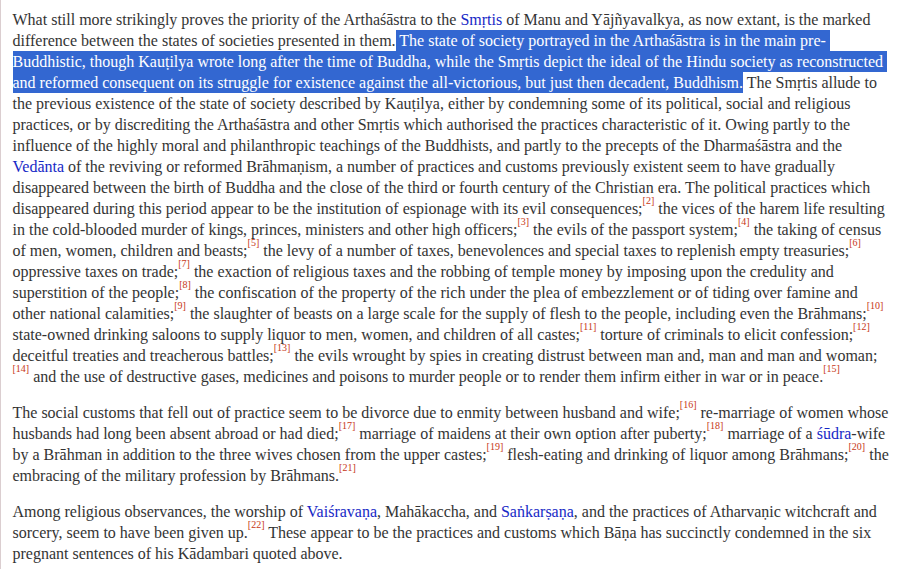
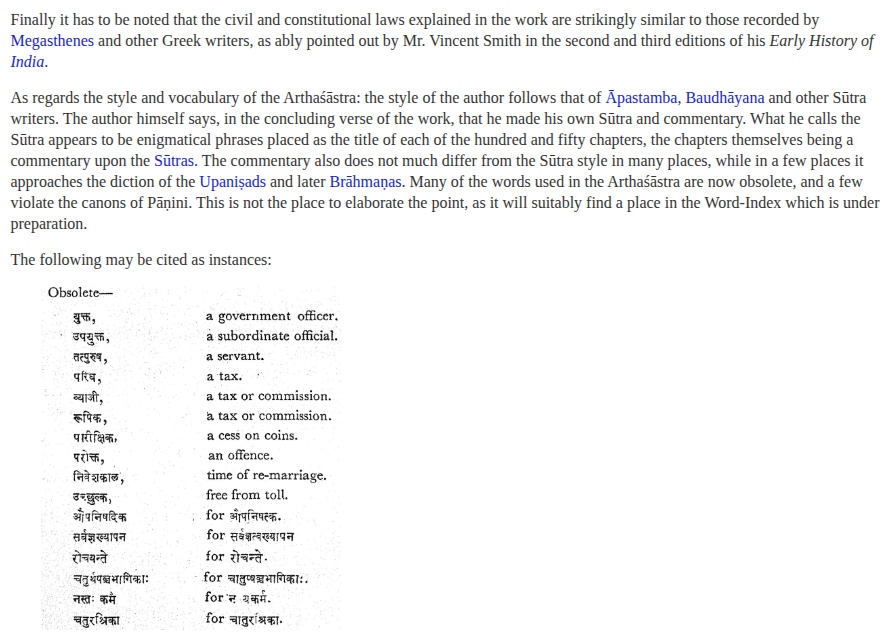
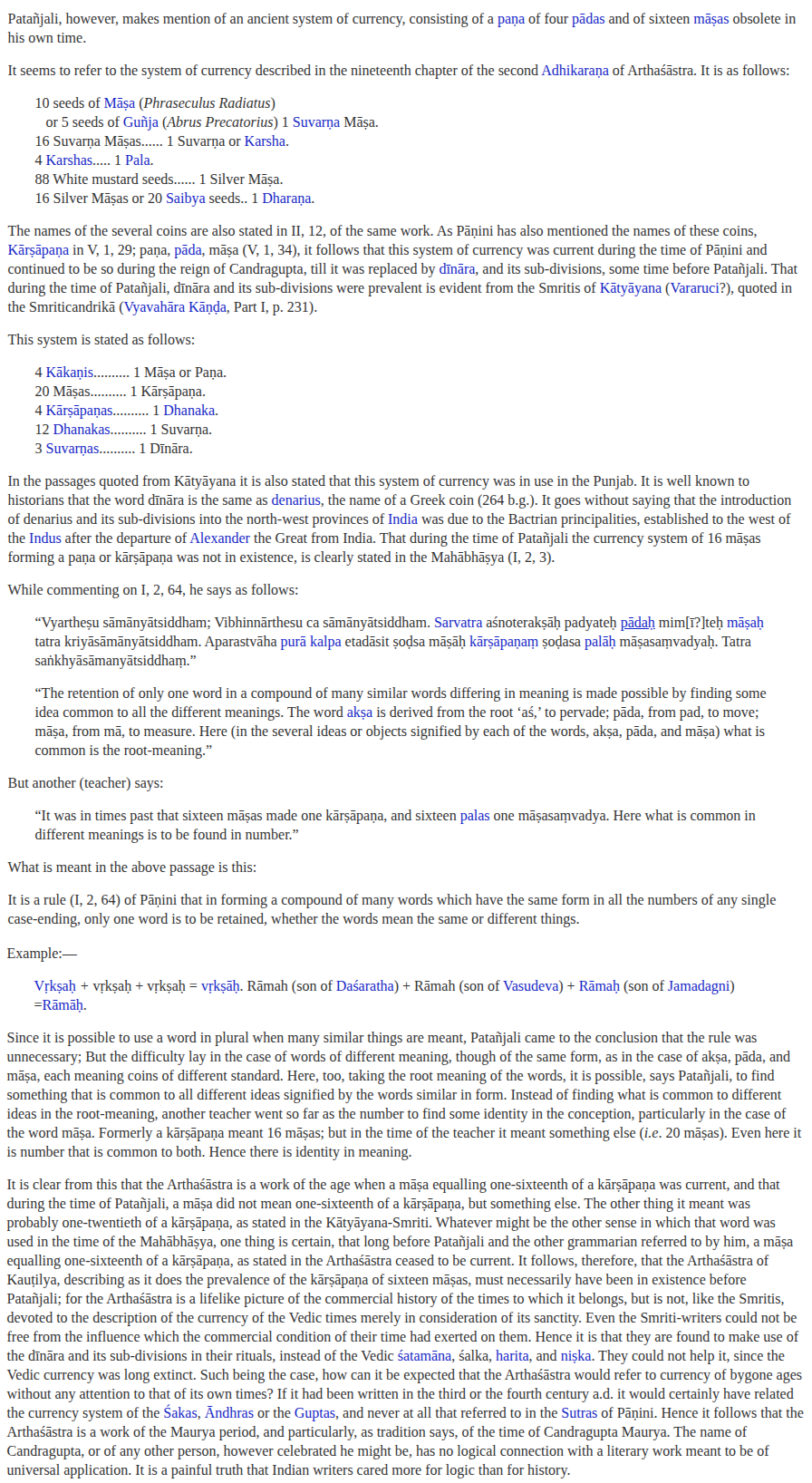
In his preface to the third edition, he summarizes the arguments given against.
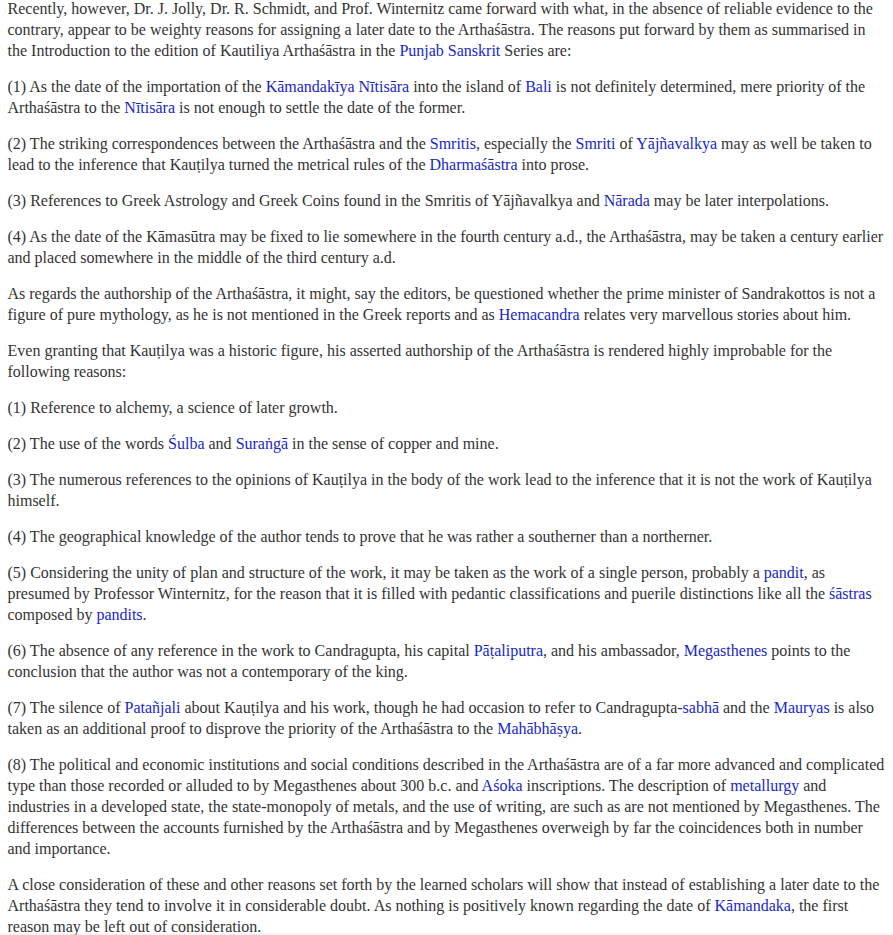
He refutes:
- the arguments presented against of the form “(Megasthenes/Patañjali) does not mention Cāṇakya” can at best reduce certainty in the traditional date, rather than ascertain a later one (and even that is limited: hardly any ministers of any administration are named in any such texts, and Patañjali does not mention e.g. Buddha or Aśoka either)
- No evidence is presented for the claim that alchemy, metallurgy or political institutions in Mauryan times were less advanced than described in the Arthaśāstra. Many claims of differences between the two are due to sheer negligence by contesting historians, e.g. Vincent Smith and others claimed that “management of departments by boards, as stated by Megasthenes, was unknown to Kauṭilya.” (a laughable claim to anyone familiar with the manuscript). I would add that it is expected that a foreign traveller’s account would be far less detailed than a comprehensive manual of statecraft, and the many resemblances are strikingly strong.
- Plenty of Indian writers referred to themselves in the third-person; it is bizarre to present this as evidence that the manuscript was authored by someone else
- The argument that the Arthaśāstra does not mention Candragupta provides no evidence one way or the other: it claims that its author Kautilya uprooted the Nandas, so if the text was a later fabrication the author could have equally inserted a mention of Candragupta
- Finally I would add, the mention of Cīna is not a counter-argument: Qin was the Westernmost state, thus the closest to traders, like Ionia deriving Yavana for Greece.
Frankly, the Mauryan context of the Arthaṣāstra is obvious to anyone who has read the text, and attempts to cast doubt on this reads at this point like a Yes Minister episode.
The new class of leftist activists LARPing as historians neither possess the intelligence and knowledge of the Western writers whose talking points they ape for their political purposes, nor do they even bother to engage with what Shamasastry himself has already said.
Also, on this note, we might comment on the date of the Kāmaṇḍaka Nītisāra. Kāmaṇḍaka is traditionally held to be a student of Kautilya, and thus immediately subsequent to him. Modern historians refute this on the basis that “it mentions a benovelent Yavana king, which must refer to Kaniṣka”. But if you actually look at the text, it never mentions “Yavana”, it mentions “Vaijavana”—which may far more naturally be read as the easily-recognizable patronym “Paijavana” of Vedic fame.
Manmatha Nath Dutt describes a legend of a Vaijavana descended from a certain Indrasena of the “Sagara dynasty”, though I have not found the primary source for this. There is also Manusmṛti 7.41 which mentions Sudās and Paijavana in the same line as Nahuṣa (the king mentioned in contrast to Paijavana in the Nītisāra) and MBh 12.1.60 which contains a similarly alluding story about Paijavana; Paijavana is also often mentioned in Śaiva texts including the Skanda Purāṇa as an exemplary king of Śūdra birth.


https://archive.org/details/kamandakiyanitis00kamarich/page/n7/mode/2up
https://www.wisdomlib.org/hinduism/book/the-mahabharata-mohan/d/doc826016.html
https://www.wisdomlib.org/hinduism/book/the-skanda-purana/d/doc502222.html
Links to Shamasastry’s arguments:
https://www.wisdomlib.org/hinduism/book/kautilya-arthashastra/d/doc365573.html
https://www.wisdomlib.org/hinduism/book/kautilya-arthashastra/d/doc365575.html
0.3. Chariot allegory
This is of course from the Kaṭha Upaniṣad, but interestingly Plato in Phaedrus uses the same “chariot allegory”, and in the same section goes on to describe a karma based reincarnation system.
IMO the Indian influence on Greek philosophy is undeniable.
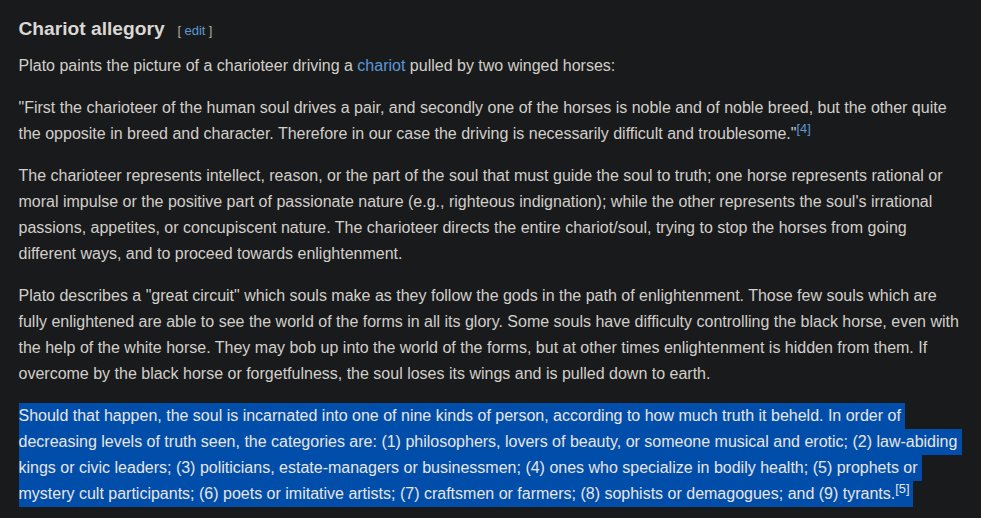
0.4. worm gear
Wikipedia, in multiple locations, states “the worm drive cotton gin was invented in India during the time of the Delhi sultanate”, citing Irfan Habib.
This is … technically true, except that Habib actually writes that the technology appeared in peninsular India, as the technology was widespread in the South but not the North.
While the Delhi Sultanate invaded South India in the early 14th century, these were brief murderous raids that could hardly be said to be responsible for any innovation.

1. Hinduism, caste and narratives
Left-wing myth: Everything is about caste system, etc.
Right-wing overcorrection: The caste system was created by the British to divide Indians, until then it had only to do with your occupation or how good a person you are.
Left-wing myth: Hinduism bad, Buddhism etc good.
Right-wing overcorrection: Buddhism was a part of Hinduism; one can’t exist without the other (Vivekananda “Brahmanical intellect and Buddhist emotion”).
Left-wing myth: Hinduism is oppressive etc.
Right-wing myth: No, Hinduism is nihilistic! You can be environmentalist and be Hindu!
Truth: … A sandwich doesn’t become nihilistic because it doesn’t tell you who to vote for
Left-wing myth: Hinduism is oppressive, etc.
Right-wing overcorrection: No, Hinduism is liberal!
Truth: I really hate the meme “Hinduism is inherently liberal”, because literally none of the words in that sentence has a precise definition, bar maybe “is”. … Brahmahatya and free speech
Left-wing myth: Ashoka narrative
Right-wing overcorrection: None.
Left-wing myth: Buddhism used to be the majority religion in India.
Right-wing overcorrection: None.
Left-wing myth: Ashoka’s persecutions were “sectarian propaganda”.
Right-wing overcorrection: None.
2. The strengths of Ancient India
Left-wing myth: All Indic technologies were courtesy of some sort of foreign invasions, Indian civilization was inferior to European, Chinese and even Middle-Eastern civilization.
Right-wing overcorrection: Ancient India was incomprehensibly advanced: we had the internet, nuclear bombs, aeroplanes and smartphones, the ancients knew string theory.
Link to “What did ancient India look like?”.
Left-wing myth: Indian civilization never had an influence on any Western/Middle Eastern civilizations.
Right-wing overcorrection: All civilizations, their science and technologies, are due to India.
The truth: India had an outsized impact on Western civilization, more than the West did on India pre 1400 or even that India did on East Asia. Fibonacci, Pythagoras, Islamic golden age. … a particularly weird claim is that “importers are the dominant trade partner” – I have no idea what this means, considering that at the end of the day all trade is bilateral etc.
Left-wing myth: The Maurya empire is not as large as it was, it was just a bunch of cities and roads.
Right-wing overcorrection: None.
Left-wing myth: Ancient India did not have a writing system until the Mauryas; the Brahmi script was created by Ashoka based on Aramaic for his imperial inscriptions.
Right-wing overcorrection: The Brahmi script descends from the ancient Indus Valley script; India has had an unbroken literary tradition from 3300 BC or even earlier.
Left-wing myth: Taxila was Persian, not Indian! Panini was a Persian subject!
Right-wing overcorrection: Persia is also Indian!
… Panini likely lived during Nanda/Maurya times
Left-wing myth: Ancient Indian explorers weren’t a thing.
Right-wing overcorrection: Ancient Indian explorers made their way to the Americas, the Mahabharata describes a full-fledged world map [1]
The truth: Indian exploration and influence in SE Asia, Africa, West; Chola shipbuilding; Indian merchant dominance
Right-wing myth: Ayurveda is scientific and can co-exist with modern medicine.
Left-wing overcorrection: Ayurveda is complete hogwash, no medicinal innovation existed until the modern world.
3. Foreign invasions and ancient militaries
Left-wing myth: Islamic invasions were great for India, they introduced more mechanization in India and increased the GDP.
Right-wing overcorrection: All Muslim rulers in India were destructive barbarians and all Indic rulers were great and noble administrators.
Left-wing myth: Akbar, mysore GDP claims
Right-wing overcorrection: Akbar and Tipu Sultan were terrible rulers who impoverished their subjects.
Left-wing myth: The fact that India was invaded several times from the West but rarely invaded the West implies that it was militarily (or even technologically) inferior to the West.
Right-wing overcorrection: No, it means we just lacked unity/they used trickery against us, we were too honorable/Indians did conquer the West, Vikramaditya conquered the entire world, and the Aryans originated in India as well.
I don’t know the explanation. Overconfidence, etc. BS about “Indians used astrology”. You know, this is something which historians are simply biased against India: they’ll call someone like Hannibal a “tactical genius” (he was not) for his recorded failures, and make up some non-existent failures for India. I will note a couple of things, however: steppes were hard to control, the steppe empires also lost them after entering India/Persia, etc. But this is not in itself an explanation: why wasn’t India more fortified, if it was so valuable? Shouldn’t some equilibrium have been reached. The truth is, a far more detailed, scientific theory of ancient warfare is needed, and this is a technical problem with the humanities, not merely a question of biases, etc.
Left-wing myth: War elephants are overrated; their only advantage was in damaging the enemy’s morale. They could easily be panicked and routed, or surrounded by a phalanx and hacked down.
Right-wing overcorrection: None.
I don’t understand how anyone with any knowledge of ancient military history could possibly believe this.
4. Notes on barbarians
4.1. Āryan invasions
4.2. Alexander
Greco-Roman sources, in chronological order of events – tell me if I’ve missed anything:
[At Aornos, in the part of Gāndhāra West of the Indus river, ruled by the Aśvakāyanas] He offered sacrifice upon it, and arranged a fort, committing the superintendence of the garrison to Sisicottus, who long before had deserted from the Indians to Bessus in Bactra, and after Alexander had acquired possession of the country of Bactra, entered his army and appeared to be eminently trustworthy.
But not even on this account was Alexander angry with Porus; but he kept on sending others in succession; and last of all Meroës an Indian, because he ascertained that he was an old friend of Porus. As soon as the latter heard the message brought to him by Meroës, being at the same time overcome by thirst, he stopped his elephant and dismounted from it. After he had drunk some water and felt refreshed, he ordered Meroës to lead him without delay to Alexander; and Meroës led him thither.
[After the war against Porus] Messengers also came from Sisicottus, viceroy of the Assacenians (Aśvakāyanas), to inform him that those people had slain their governor and revolted from Alexander. Against these he despatched Philip and Tyriaspes with an army, to arrange and set in order the affairs of their land. He himself advanced towards the river Acesines (Chenab).
Alexander marched thence into the Patalian territory. Its king was Moeres, but he had abandoned the town and fled for safety to the mountains.
---Curtius, 9.8, c. 1st century
Now, I am something of a fanboy of Alexander myself, but I find the Greek records after the battle with Porus to be possibly unreliable. The account of Alexander fetching for Moeres – all the way from the Swat Valley – right in the middle of battle (with Porus fighting for that entire duration) seems almost mythological, that’s a 3-day journey (double of that for the back and forth) by foot even today. Several more implausible accounts appear in the story afterward:
· The Aśvakāyana rebellion threatened to completely cut off Alexander’s supply lines from the West, yet he seems to have cared little for it, proceeding to conquer regions in Punjab further East.
· … which he apparently did by the end of the monsoon (which is possible if you had done significant planning, planting spies and turning loyalties beforehand – but he is to have done this (with comparatively little detail of all of these battles, except of the names of the tribes and their cities).
· The names of the tribes of Eastern Punjab seem disconnected from their identifications based on Pāṇini, and indeed the accounts between different writers are different – suggesting that they may have been made up based on a vague knowledge of the region.
· Abisares, a king based somewhere near Kashmir, presented a constant nuisance for Alexander: he first supported the Aśvakāyanas in their defense against Alexander, then provided them refuge after their defeat (Arrian 4.30), then apparently sent him an embassy once Taxila surrendered (Arrian 5.8), yet moved to help Porus against Alexander, albeit too late (Arrian 5.20), then sent Alexander gifts again at the end of the monsoon (Arrian 5.29), excusing his absence claiming illness despite Alexander previously having demanded he show himself (5.20), yet Alexander “readily believed that such was the case” and appointed Abisares as satrap, even placing the allied king Arsakes under his dominion – and took no measures to stop him from rebelling, despite the obvious threat he posed to his supply line.
· In his Southward expedition into the Sauvīra country, rather vague explanations are given as to whether Alexander really fought against the Kṣudrakas, Śivis and Agalassoi or merely prevented them from allying with the Mālavas.
· The descriptions of all of Alexander after Porus border on a mythological hero – with him jumping past the Mālava walls alone in the midst of a siege, or pursuing the king of Pātāla who had apparently fled the country with “all his people”.
· He made no attempt to take Sattagydia, or the Kekaya country (which I have labelled as part of Gāndhāra in this map but there is no real basis for this).
· The picture of Alexander’s territories in India at the time of his departure were obviously unstable and in constant rebellion when he left, very different from the situation back in the West. Alexander would have known that he hadn’t really consolidated his rule.
My take: All of Alexander’s actions after his Pyrrhic victory against Porus were taken out of desperation — out of having his army seriously weakened, and from having his supply lines cut off by Śaśigupta (which was already quite unstable, e.g. depending on a road that his own army had to build, Arrian 4.30) — to find and establish new routes back to Babylon. All of his further Eastward marches are false, or they were really assignments he gave to Porus or Eudemus – instead he travelled Southward.
The destruction he inflicted in Sauvīra and Sindh were probably real (mainly because a jauhar is described, a ritual he could not have otherwise known of – and because of an interesting passage in the Arthaśāstra, see below), but undertaken either out of a sort of “If I can’t have it no one can” desperation, or to please his restless soldiers, or in defensive fights against armies, such as Maurya’s, that sought to obstruct his passage and trap him completely. [while in Sauvīra he still probably expected Philip to quell the rebellion in the North – but by the time he had gotten to Sindh, he just sought to escape the place.
This also explains the apparent mystery of why Alexander marched his army back through the desert – he really was quite unaware of routes back to Babylon at this point, even though he could have learned it from the Persians or from merchants, e.g. he had thought the Indus was the source of the Nile (Arrian 6.1), and was seeking all possible routes back to the West, thus he sent Craterus back early through Arachosia, himself through the desert, and Nearchus by ship, not knowing which routes were really possible.
I do not believe the theory pushed in some RW circles that Alexander was actually defeated by Porus, though – mainly because of this passage by Kautilya.
When a king of poor resources is attacked by a powerful enemy, he should surrender himself together with his sons to the enemy and live like a reed (in the midst of a current of water).
Bhāradvāja says that he who surrenders himself to the strong, bows down before Indra (the god of rain).
But Viśālākṣa says that a weak king should rather fight with all his resources, for bravery destroys all troubles; fighting is the natural duty of a kṣatriya, no matter whether he achieves victory or sustains defeat in battle.
No, says Kauṭilya: he who bows down to all like a crab on the riverbank lives in despair; whoever goes with his small army to fight perishes like a man attempting to cross the sea without a boat. Hence, a weak king should either seek the protection of a powerful king or maintain himself in an impregnable fort.
—Kautilya, in the Arthaśāstra, 12.1:1-9
This is probably the only bit of Indian literature even vaguely referencing the events of Alexander’s invasion – it really reads like Viśālākṣa was the advisor of Porus, while the tribes ruling Sauvīra (especially the Mālavas) had followed Kautilya’s advice, and Kautilya uses this as a lesson.
4.3. Maurya-Gupta Interregnum
4.4. Identity of Kambojas, Scythians, Pratiharas
https://archive.org/details/in.gov.ignca.36138/page/53/mode/2up Abhiras their history and culture (Bhagwansingh Suryavanshi) https://en.wikipedia.org/wiki/Ishwarsena
4.5. Crackpot Islamist narratives
4.6. A comparative perspective
The popular conception of Ancient Indian civilization is as a militarily weak one – one which was often subject to foreign invasions, but which never invaded any territory outside its boundaries (with the one exception of the Chola invasion of Srivijaya noted under an asterisk), often attributed to “the foolishness of our kings” or our insularity.
It is worth having a comparative perspective on things. Here is a full list of periods of foreign occupations in frontier regions of India during the 2000-year period of idiomatic Indian history (800 BC - 1200), compared to other civilizations: 1
- Takṣaśilā: 511 years. Achaemenid (518 BC - 418 BC), Greek (170 BC - 100 BC, 57 BC - 45 BC), Scythian (100 BC - 57 BC, 45 BC - 12 BC), Parthian (19 - 50), Kushan (78 - 250), Hun (470 - 520).
- Śākala: 180 years. Greek (160 BC - 100 BC), Scythian (0 - 20), Kushan (100 - 200).
- Sindhu: 440 years. Greek (170 BC - 70 BC), Scythian (WS) (10-78, 78 - 200), Sassanian (200-300), Hun (470 - 520).
- Mathura: 140 years. Scythian (10-50), Kushan (100-200).
- Ujjayini: 172 years. Scythian (WS) (78-250).
- Persia: 1163 years. Median (610 BC - 550 BC), Greek (330 BC - 160 BC), Parthian (160 BC - 224), Caliph (651 onward).
- Mesopotamia: 1745 years. Wasn’t ever independent after 545 BC.
- Egypt: 2000 years. Wasn’t ever independent in this period.
- Northern China: 284 years. Under the Conquest dynasties from 916 onward.
- Sicily: 700 years. Phoenician (800 BC - 250 BC), Islamic (850 - 1000)
- Sardinia: 700 years. Phoenician (800 BC - 250 BC), Islamic (750 - 900)
- Corsica: 550 years. Phoenician (800 BC - 250 BC)
- Spain: 1100 years. Phoenician (800 BC - 200 BC), Islamic (700 onward)
- Romania: 200 years. Hun (380 - 450), Avar (570 - 800)
You will note that in terms of resisting foreign invasions, India was on par with Europe, vastly stronger than the Middle East, and weaker than China. Some opinionated ranting about the absolute state of Indian history has been relegated to a footnote.
Generally, India was politically insular (didn’t invade much, didn’t get conquered much), culturally and scientifically/technologically it was very influential on the rest of the world, but slow in uptaking from the rest of the world. 2
The only reason we talk about the invasions of India is that we actually successfully resisted them, and that our identity has remained fairly constant throughout the ages – unlike other civilizations which were conquered so thoroughly they no longer even regard their conquerors as invaders (e.g. the Middle East was once Christian). Perhaps the words of Ferdowsi, lamenting the Islamic conquest of Persia while himself being a devout Muslim, shed light on how other civilizations viewed their conquerors:
How can this happen? That the faithless [Arabs] will come to a land … from them the faithful [Persian Muslims] have risen.
—Ferdowsi, in the Shahnameh, c. 1000
Who’s a barbarian?
Note that this only counts occupations, so e.g. the Indo-Greek invasions of Mathura, or the Achaemenid invasions of Greece are not counted – see here for a fuller analysis. I have counted the Western Satraps even though they were probably of significant Apracarāja (Aśvaka) and Abhira (Kashmiri) heritage.
It’s also worth noting that in the case of other civilizations, foreign conquests were so thorough we don’t even regard them as conquests anymore – e.g. the fall of Rome to Christianity, the Islamic conquest of the once-Christian Middle East, many Byzantine rulers were from modern-day Turkey, the complete replacement of the Austronesian civilizations of Southern China by Han expansion. We think about foreign invasions of India at all, only because we actually resisted them enough to still consider them “foreign”.
5. Misc
Yeah. The Dasyus were a specific Iranic tribe the early Āryas conquered, it was not that the Iranians as a whole were inimical.
Zoroastrianism and its demonization of Devas post-dated this and was just a separate religious reformation not different from those within Hinduism.
Also, Asura-worship was not a Zoroastrian innovation. “Asura” always meant ~Mighty One in Indo-European religion (see Germanic Æsir).
Both gods and enemies were praised as Asuras for their might in the Vedas, but it grew a negative connotation because:
Complimenting your enemies for their strength was historically universal. You want to be known as the man who slew a dragon, not a guy who squashed a worm.
Moderns see e.g. praise of Karṇa’s skills in MBh and start worshiping him because they lack the concept of a Titanic Foe